Accelerate Productivity in 2025
Reignite Growth Despite the Global Slowdown
Executive Summary: What are the Top 10 Trends in Medical Research in 2026 & Beyond?
- Artificial Intelligence (AI) Integration: About 69% of pharma and biotech firms use generative AI for drug discovery and clinical trial optimization. Over 81% of these organizations report increased revenue and reduced R&D costs.
- Patient Safety Innovations: The World Health Organization’s (WHO) safety plan targets a 50% reduction in preventable harm by 2026, yet only one-third of countries have full national strategies. The Medical Research Future Fund allocates USD 1.43 billion for clinical trials and safety innovations between 2024 and 2034.
- Regenerative Medicine Advances: Market projected to reach USD 397.7 billion by 2037 with a 16.3% compound annual growth rate (CAGR). Companies like Windward Bio and Aspect Biosystems raised USD 200 million and USD 115 million, respectively, to advance long-acting antibody and bioprinted tissue therapies.
- Immunotherapy Innovations: The market is expected to surpass USD 829.8 billion by 2032, with CAR-T and other cell therapies expected to generate USD 12 billion by 2027. Over 74% of new trials in 2025 target non-cancer immune diseases, which is 16% from previous periods.
- CRISPR & Gene Editing: The market is forecasted to reach USD 16.47 billion by 2034, with CRISPR Therapeutics spending USD 82.2 million in Q4 2024 on R&D for clinical programs. Over USD 2 billion was invested in CRISPR startups in 2023 alone.
- Quantum Biology & Computing: Market projected to exceed USD 1.3 billion by 2030 at 37.9% CAGR. The University of Chicago secured USD 21 million in 2025 for quantum biology labs.
- mRNA & Nucleic-Acid Therapeutics: The global mRNA market is expected to grow past USD 21.45 billion by 2032 with a 19.9% CAGR. Cancer-specific mRNA therapies projected to reach USD 262.1 billion by 2035.
- Organoids & Organ-on-Chip Models: The size of the organoids market grows at a 22.5% CAGR annually, with USD 6.5 billion projections by 2033. Organ-on-chip is projected to exceed USD 10.10 billion by 2033.
- Nanomedicine & Smart Drug Delivery: Nanomedicine is expected to reach USD 799.6 billion by 2034, while smart drug delivery reaches USD 48.3 billion. Nanobiotix received up to USD 2.7 billion in milestone-based deals.
- Virtual & Decentralized Clinical Trials (DCTs): The DCT market is expected to grow to USD 21.34 billion by 2030, with North America and Europe reaching USD 9.13 billion by 2026. Decentralized trials already save 10-25% in costs and improve recruitment speed.
Read on to explore major trends in medical research in depth – uncover key drivers, current market stats, cutting-edge innovations, and medical research leading innovators shaping the future.
Frequently Asked Questions
1. What is the future of medical research?
AI will innovate diagnostics, drug discovery, and personalized treatments. Digital health tools and decentralized trials are expanding remote monitoring and improving access to diverse patient groups while ensuring data quality.
2. What is the biggest challenge in clinical trials?
Poor participant recruitment and retention lead to early termination of up to 55% of clinical trials.
3. How big is the medical research industry?
Global clinical trials market projected to reach USD 149.58 billion by 2034 at a CAGR of 6.10%.
Methodology: How We Created the Latest Trends in Medical Research Report
For our trend reports, we leverage our proprietary StartUs Insights Discovery Platform, covering 7M+ global startups, 20K technologies & trends, plus 150M+ patents, news articles, and market reports.
Creating a report involves approximately 40 hours of analysis. We evaluate our own startup data and complement these insights with external research, including industry reports, news articles, and market analyses. This process enables us to identify the most impactful and innovative medical research trends market.
For each trend, we select two exemplary startups that meet the following criteria:
- Relevance: Their product, technology, or solution aligns with the trend.
- Founding Year: Established between 2020 and 2025.
- Company Size: A maximum of 200 employees.
- Location: Specific geographic considerations.
This approach ensures our reports provide reliable, actionable insights into the medical research innovation ecosystem while highlighting startups driving technological advancements in the industry.
Innovation Map outlines the Top 10 Trends in Medical Research & 20 Promising Startups
For this in-depth research on the Top Medical Research Trends & Startups, we analyzed a sample of 4340+ global startups & scaleups. The Medical Research Innovation Map created from this data-driven research helps you improve strategic decision-making by giving you a comprehensive overview of the trends in the medical research industry & startups that impact your company.
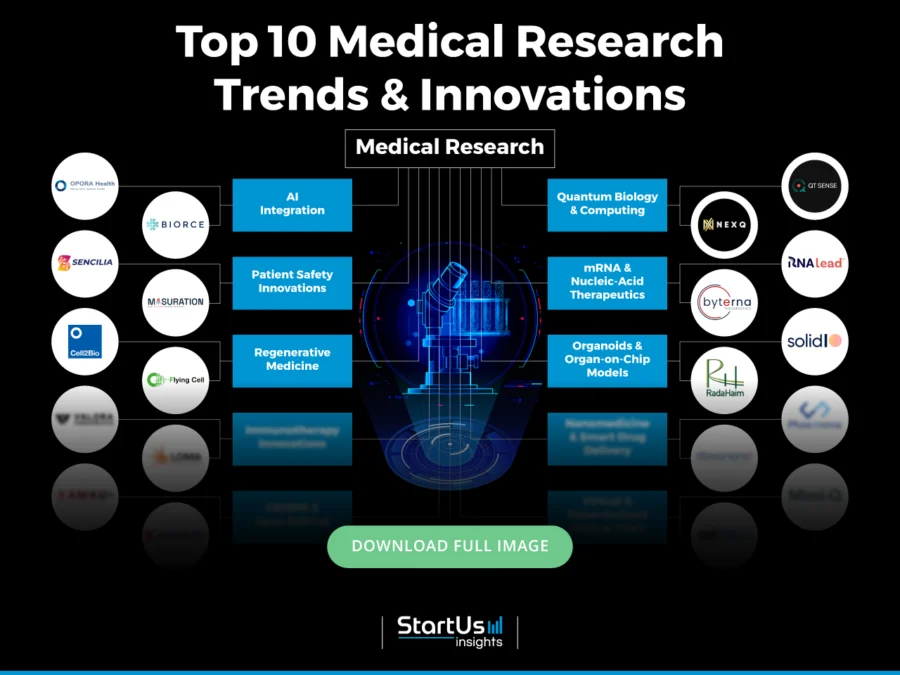
Tree Map reveals the Impact of the Top 10 Trends in Medical Research
Based on the Medical Research Innovation Map, the Tree Map below illustrates the impact of the Top 10 Medical Research Trends. AI enables predictive diagnostics, speeds up drug development, and powers digital twins for clinical trials. Wearables and remote biosample tools convert patients into active data sources.
Meanwhile, environmental, health, and safety (EHS)-inspired platforms simplify regulatory compliance, data capture, and clinical workflows. Immersive tools and mobile apps improve patient engagement and staff training across decentralized trials.
Gene editing, immunotherapy, and regenerative medicine are becoming more precise with smart delivery systems, AI-driven design, and modular manufacturing. Meanwhile, organ-on-chip models and 3D cultures improve disease modeling and drug testing beyond traditional methods.
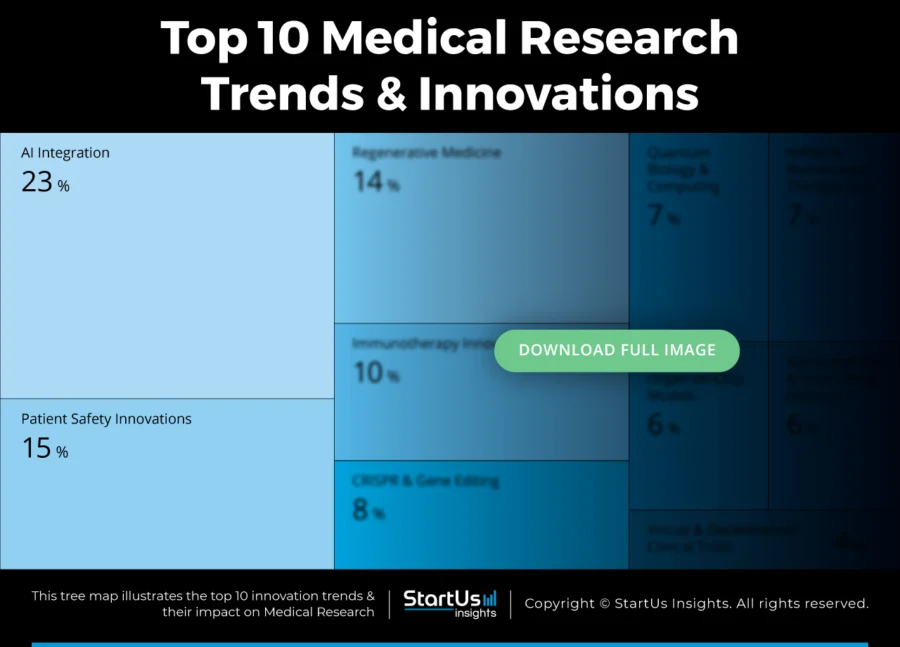
Global Startup Heat Map covers 4340+ Medical Research Startups & Scaleups
The Global Startup Heat Map showcases the distribution of 4340+ exemplary startups and scaleups analyzed using the StartUs Insights Discovery Platform. It highlights high startup activity in the USA and India, followed by the UK. From these, 20 promising startups are featured below, selected based on factors like founding year, location, and funding.
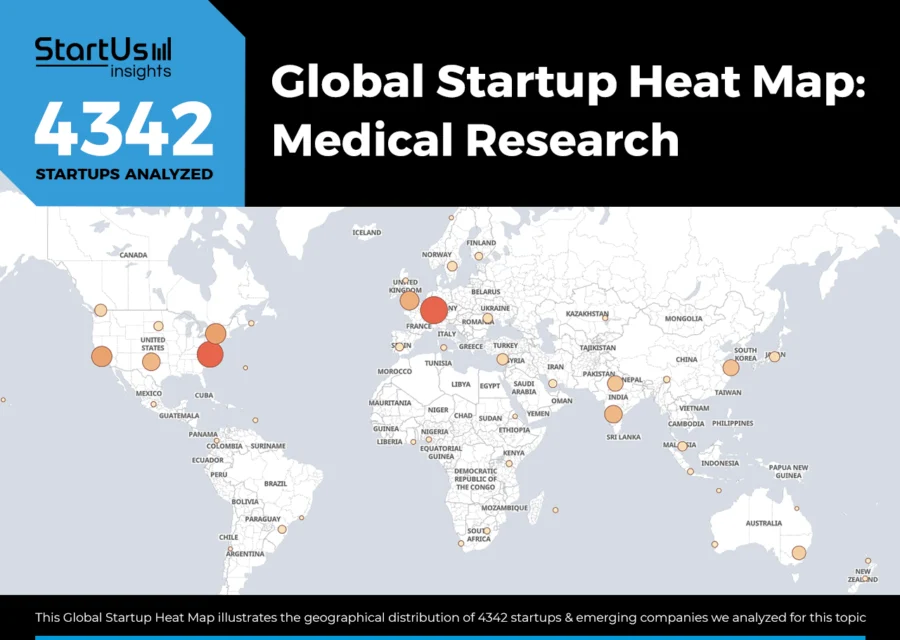
Want to Explore Medical Research Innovations & Trends?
Top 10 Emerging Trends in Medical Research [2026 & Beyond]
1. AI Integration: Market to reach USD 110.61 B by 2030
AI integration improves medical research with precise diagnostics, faster drug discovery, and personalized patient care. The global healthcare AI market is projected to grow from USD 21.66 billion in 2025 to USD 110.61 billion by 2030 with a CAGR of 38.6%. Within this, pharmaceutical AI alone is set to reach USD 9.64 billion by 2029, which is nearly three times its current size.

Credit: The Business Research Company
In support of this momentum, Xaira Therapeutics raised over USD 1 billion to build a virtual cell. It is a data-driven platform that predicts cellular responses to interventions, like drugs or gene edits, using AI. Another instance is Spring Health raising USD 100 million in a Series E funding round. Its platform uses AI to connect patients with the right care providers and personalized treatment plans.
Moreover, Proscia works with 16 of the top 20 global pharmaceutical firms. Its Concentriq digital pathology platform supports over 32 000 patient cases daily. The platform utilizes built-in AI to create targeted treatments, companion diagnostics, and clinical decisions. The company received a USD 50 million investment and brought its total funding to USD 130 million.
Despite these investments, complex data, slow diagnostics, and rising trial costs limit the progress of medical research. A shortage of healthcare workers, expected to reach 10 million by 2030, pushed organizations to adopt AI tools to reduce delays and fill skill gaps.
To address these issues, innovators like Insilico Medicine and Unlearn offer AI-powered solutions. Insilico Medicine leverages generative AI software to design nanoparticles that deliver drugs directly to cancer cells. Additionally, Unlearn utilizes AI to create digital twins for clinical trials. These models reduce the number of human participants while saving costs and time.
Beyond individual use cases, adoption rates show AI’s growing influence. About two-thirds of healthcare and life sciences organizations report using AI in their workflows. Additionally, about 69% of pharma and biotech firms use generative AI for drug discovery and clinical trial optimization. Over 81% of these organizations report increased revenue and reduced R&D costs.
OPORA Health Technologies builds a Neuro-Symbolic Technology
UK-based startup OPORA Health develops an AI-powered platform for ethical and inclusive medical research. Its neuro-symbolic technology combines human ethical requirements and AI processing.
The AI-powered platform collects and validates real-time data from user devices to support passive sensing, self-reports, clinical questionnaires, and multilingual interfaces. Moreover, its decision support feature utilizes explainable AI, predictive analytics, and tools for exploring anonymized patient data through knowledge graphs.
Biorce develops a Clinical Trial Assistant
Spanish startup Biorce offers Jarvis, an AI-powered assistant that simplifies clinical trial navigation for patients, physicians, and researchers.
The AI-powered assistant uses natural language processing (NLP) and real-time data analysis to assist businesses in asking questions, exploring clinical trial trends, and understanding eligibility criteria with clarity.
Further, the assistant offers a user-friendly interface that reduces complexity, supports smart study design, and enables targeted patient recruitment through AI-driven matching.
2. Patient Safety Innovations: WHO Sets 50% Harm Reduction Goal
Patient safety innovation continues to grow as AI, cloud platforms, digital diagnostics, and remote monitoring come together to improve medical research workflows. While these tools enhance care, major problems still exist. Many health systems use outdated technology, adopt safety protocols slowly, and face staff burnout. This affects reliability and patient outcomes.
The WHO Global Patient Safety Action Plan shapes new safety policies in over 100 countries. However, only one-third have national plans, and less than a quarter promote a strong safety culture or use human-factors methods to avoid errors. These gaps lead to preventable harm, especially in areas like medication errors, infections, surgical safety, and misdiagnosis. Additionally, WHO aims to reduce this harm by half by 2026.
Investments show growing trust in patient-focused research. For example, the Medical Research Future Fund sets aside USD 1.43 billion for clinical trials and safety innovations from 2024 to 2034. It also projects over USD 2.2 billion in cumulative support for translational research and advanced medical technologies.
Meanwhile, digital health startups targeting patient safety receive decisive support. Truveta collected USD 320 million to build a system that joins medical records with patient outcomes at scale. For instance, Innovaccer raised USD 275 million to expand AI tools that support clinical decisions and patient safety workflows. Further, Retro Biosciences received USD 1 billion to develop cell therapies with safer profiles for age-related trials.
However, the sector still faces challenges. Outdated information technology (IT) systems and poor data connections delay the use of complete patient records and, in turn, limit risk tracking. Only 23% of health systems design operations with human-factors thinking. Medical safety training remains low, with fewer than 20% of professionals receiving it during education. Also, AI models face issues like data bias, privacy concerns, and a lack of standard formats. This makes it challenging to scale solutions globally.
Nevertheless, several companies work on tackling these challenges. For example, Castor improves clinical trial management by leveraging digital tools to capture patient data remotely and manage studies with algorithms. Aiforia brings AI into pathology labs to reduce errors and improve consistency across countries.
Sencilia simplifies Infusion Flow Monitoring
Dutch startup Sencilia creates Rely-V, an AI-integrated intravenous (IV) flow monitoring technology to improve drug safety in neonatal and pediatric intensive care. The technology utilizes microelectromechanical sensors to measure drug flow rates at the vascular access point and detects variations at rates below 5 mL/hr.
Moreover, the flow monitoring technology offers wireless, real-time alerts for abnormal flow rates and enables continuous remote monitoring without bedside presence. The startup’s reusable, non-contact sensor also avoids contamination and attaches to standard IV tubing for preserving existing clinical workflows.
Masuration makes a Surgical Navigation System
Austrian startup Masuration provides Noctopus, a surgical navigation system to improve patient safety and surgical accuracy. The system’s non-invasive registration method automatically determines the optimum marker configuration to remove errors and reduce the need for extensive training.
Further, Noctopus supports integration with tracking systems and imaging technologies, including computed tomography (CT), magnetic resonance imaging (MRI), positron emission tomography (PET), and fluoroscopy.
3. Regenerative Medicine Advances: Market to Reach USD 397.7 B by 2037
Precision in regenerative medicine expands the global market, with rising clinical adoption improving therapies for chronic, rare, and degenerative diseases. Projections show the market reaching USD 397.7 billion by 2037, at a CAGR exceeding 16.3% from 2025 to 2037.

Credit: Market.us Media
At the same time, intensifying public and private capital inflows shape a competitive investment environment. For example, Windward Bio secured USD 200 million in Series A funding to advance long-acting monoclonal antibody therapeutics for severe respiratory and advanced immunological diseases.
Similarly, Aspect Biosystems received USD 115 million in Series B to support clinical programs focused on bioprinted tissue therapies using its computational design tools and biomaterials.
Despite strong progress, the sector continues to face limited tissue vascularization, immune rejection, and complex manufacturing processes. Solutions, like smart biomaterials, robotics, AI in production, and modular cleanroom systems, manage these problems for both patient-specific and donor-based treatments.
For example, InGel Therapeutics introduces development platforms that generate high-quality retinal neurons using engineered precursor cell states. It addresses cell identity uncertainty and supports vision restoration. Similarly, Conexeu Sciences develops Ten-Minute-Tissue. It is a rapid skin substitute that speeds up wound healing and reduces inflammation.
Additionally, investments in manufacturing and infrastructure show a commitment to faster commercialization. FUJIFILM, for instance, invested USD 200 million into new induced pluripotent stem cell (iPSC) manufacturing and development hubs in the USA. Further, this investment is expected to double production capacity by 2026 and improve access to research and clinical-grade cell therapies.
Cell2Bio provides 3D Cell Culture
Swedish startup Cell2Bio makes a 3D cell culture platform that enables cells to form biologically relevant spheroids. The platform utilizes a low number of cells per well and supports standard plate formats. This makes it easy to adopt in existing laboratory workflows.
The platform also mimics the tumor microenvironment and predicts drug responses. Additionally, it reduces variability in cell behavior while improving the retrieval of cancer stem cells to increase reproducibility and performance.
Moreover, its use of sustainable materials and compatibility, as well as custom surface coatings, increases utility.
Flying Cell develops Magnetic Cell Therapy
Japanese startup Flying Cell offers a regenerative medicine platform that uses magnetic targeting to guide and concentrate therapeutic cells within the body. The platform employs magnetized mesenchymal stem cells combined with iron-based nanoparticles, which move under an external magnetic field.
These magnetized stem cells accumulate at specific treatment sites to reduce strain on the body and increase treatment precision, especially in joint cartilage regeneration. This way, the startup combines minimally invasive delivery with cell regeneration to provide body-friendly treatments for orthopedic and regenerative care.
4. Immunotherapy Innovations: CAR-T to Generate USD 12 B by 2027
The immunotherapy drugs market is projected to reach USD 829.8 billion by 2032. This growth follows an annual increase of about 14.49% as new treatments attract more funding for cancer, autoimmune conditions, allergies, infections, and neurological disease treatments.
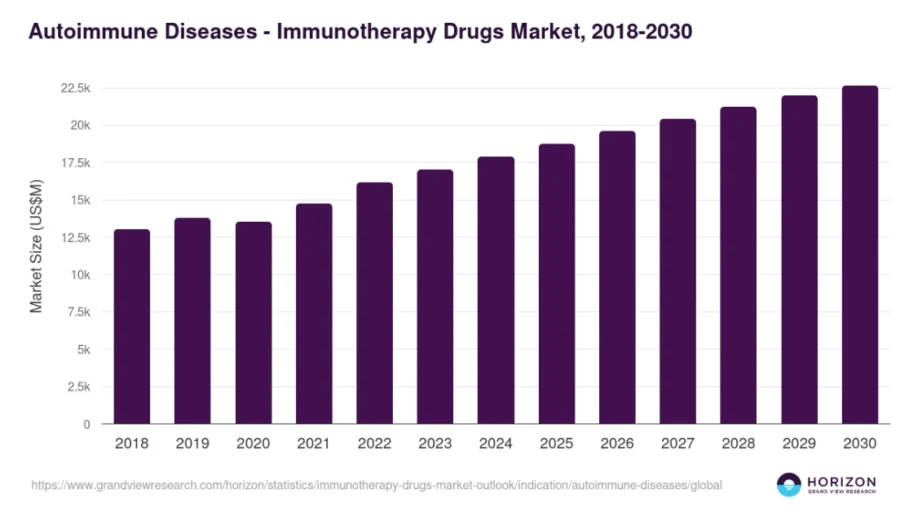
Credit: Grand View Research
For immune-related and autoimmune disorders, the market is expected to reach USD 22.6 billion by 2030, supported by new biologics and personalized therapies. Allergy immunotherapy is also expected to grow from USD 3.7 billion in 2025 to USD 5 billion by 2035.
In parallel, immunology drugs are expected to grow beyond USD 300 billion in yearly revenue by 2027. This growth comes as precision monoclonal antibodies and gene-edited cell therapies treat conditions like rheumatoid arthritis, lupus, and multiple sclerosis.
Moreover, AI-guided diagnostics support better patient selection for allergy treatment. Metropolis Healthcare, for instance, launched an AI-powered component-resolved diagnostic platform to identify specific immunoglobulin E (IgE) antibodies against food and respiratory allergens.
Differences in patient immune response, uncertain results across groups, and high costs for personalized cell manufacturing create bottlenecks. To manage this, companies offer off-the-shelf cell therapies that lower production costs and improve access. For instance, Atara Biotherapeutics‘ Ebvallo utilizes bioengineered donor cells to reduce costs, simplify logistics, and enable faster, scalable treatment for rare cancers.
Additionally, Astellas and Poseida, for example, invested USD 800 million to build off-the-shelf cell lines for areas like organ transplants and inherited immune problems.
Further, more than 40 new CAR-T and cell therapies for cancer and autoimmune diseases are expected to reach the market by 2027.
Investment patterns also show trust in technology-based solutions for difficult diseases. In early 2025, over 74% of new cell therapy trials focused on non-cancer conditions. This is a 16% rise over previous periods.
Many of these trials focus on rare genetic diseases, inflammation in the nervous system, and immune disorders in children. The major factors, like competition from biosimilars, automated production, and digital platforms, reduce system costs, improve access, and accelerate regulatory steps.
Valora Therapeutics creates Glyco-Immune Therapeutics
US-based startup Valora Therapeutics builds AbLec, an antibody-lectin chimera platform that targets and modulates glyco-immune checkpoint signaling in disease.
The platform combines an antibody domain for specific cell targeting with a lectin domain that binds to glycan structures on cell surfaces for precise immune modulation. This dual-function design supports both immune response activation and suppression depending on disease context, like cancer or autoimmune disorders.
Moreover, AbLec offers advantages in cell specificity, multifunctional action, and modular application for diverse therapeutic areas like oncology, autoimmune disorders, and infectious diseases.
Loma Therapeutics offers Human Papillomavirus (HPV) Cancer Immunotherapy
Danish startup Loma Therapeutics makes an HPV-targeted immunotherapy that addresses throat, cervical, anal, and penile cancers. The HPV-targeted immunotherapy leverages weakened viruses to deliver full HPV proteins and activate cancer-fighting cytotoxic (CD8+) T cells.
These viruses trigger a response against infected and cancerous cells to aid immune cells in showing HPV proteins. As a result, this therapy enables precise recognition of HPV-driven tumors and infected cells across disease stages.
5. CRISPR & Gene Editing: USD 2 B Invested in CRISPR Startups
CRISPR and gene editing research refines delivery systems, improves precision tools, and prepares for broader clinical adoption across genetic and rare diseases. By 2034, the global CRISPR gene editing market is expected to reach USD 16.47 billion, with a 14.77% from 2025 to 2034.

Credit: Marketsandmarkets
The broader gene editing tools market, including CRISPR kits and platforms, is set to reach USD 20 billion by 2030. Moreover, the gene therapy market, including CRISPR and related tools, is projected to grow to USD 36.55 billion by 2032 at a yearly rate of 19.4% from 2024 to 2032.
However, delivering gene editing tools into real human cells or tissues often falls short of the results seen in lab studies. This reduces editing efficiency for patients. Additionally, unwanted genetic changes, or off-target effects, raise safety concerns and slow down clinical use. Similarly, editing multiple genes at once, unclear regulations, high clinical costs, and immune reactions create challenges.
To solve these issues, researchers use new editing designs and tools. For instance, the protein design combinatorial human-mouse engineering for research applications (CHyMErA) combines CRISPR-associated protein 9 (Cas9) and CRISPR-associated protein 12a (Cas12a) to remove multiple genes.
Bioinformatics tools choose better guide ribonucleic acid (RNA) and predict protein-deoxyribonucleic acid (DNA) matches to reduce off-target edits.
Since 2025, funding has moved toward clinical-stage programs and editing platforms. CRISPR Therapeutics, for example, spent over USD 82.2 million in Q4 2024 on R&D to expand the use of CASGEVY for blood disorders.
Likewise, Editas Medicine uses its lipid nanoparticle system to target blood and liver cells, with trials for sickle cell and beta-thalassemia planned for late 2026.
Investors continue to support the sector. Over USD 2 billion flowed into CRISPR-based biotech startups in 2023. Caribou Biosciences, for example, raised USD 155 million to advance its allogeneic CAR-T cell therapy programs for cancer.
Kamau Therapeutics develops Gene Correction Therapy
US-based startup Kamau Therapeutics creates a homology-directed repair (HDR)-based gene editing platform to correct genetic mutations at the source.
It combines high-fidelity CRISPR-Cas9 ribonucleoprotein complexes with adeno-associated virus 6 (AAV6) vectors to offer precise DNA templates into hematopoietic stem cells.

Credit: Kamau Therapeutics
Moreover, the platform locates a faulty gene, creates a double-strand break, and inserts a corrected DNA sequence using the cell’s natural repair machinery.
Additionally, the platform’s main features include kilobase-length precision editing, template-driven integration, and application in blood-forming stem cells. These features propagate corrected DNA into multiple lineages. With this, Kamau repairs disease-causing mutations and restores normal gene function to offer a long-term therapeutic strategy for genetic disorders.
Immitra Bio offers Hematopoietic Stem Cells (HSC) Gene Editing
Swiss startup Immitra Bio builds a genetic medicine platform that integrates HSCs with CRISPR-Cas9 gene editing to engineer long-lasting therapies for rare diseases. The platform introduces precise genetic modifications to edit patient-derived blood stem cells and address the root cause of inherited disorders.
Further, the platform introduces targeted edits directly into the HSC genome to produce healthy blood and immune cells over time. It also minimizes systemic toxicity and applies to diverse monogenic conditions.

6. Quantum Biology & Computing: A USD 1.3 B Market by 2030
Quantum biology utilizes quantum computing and sensing to better understand molecules, improve diagnostics, and speed up new treatments. By 2030, the global market for quantum computing in healthcare is expected to cross USD 1.3 billion, with a CAGR of 37.9% from 2025 to 2030. Moreover, quantum biology is also growing, with the global market likely to reach USD 5.3 billion by 2033.
Investment activity in quantum remains strong. Qubit Pharmaceuticals, for example, attracted EUR 4.5 million for molecular modeling using hybrid quantum-classical computing. Likewise, the University of Chicago received a USD 21 million investment in June 2025 to establish the Berggren Center for Quantum Biology & Medicine, which focuses on quantum-powered biomedical research.
Despite this growth, quantum hardware often breaks easily, and building systems that correct errors takes time. Regulations also need to adjust to quantum encryption. Other issues include the unstable nature of qubits, which makes it hard to scale systems.
To manage these issues, developers use hybrid systems that combine classical processors with quantum ones, especially in drug discovery and gene research. Further, software-led tools and quantum machine learning (QML) address errors.
Progress in synthetic data and security also supports medical research. Quantum algorithms build training datasets with more accuracy and scale to study rare diseases. Quantum cryptography, especially quantum key distribution (QKD), protects medical data and improves privacy.
QTSense develops a Quantum Biosensing Platform
Dutch startup QT Sense offers Quantum Nuova, a precision sensing platform that uses luminescent nitrogen-vacancy (NV)-center nanodiamonds. It measures free radical activity in living cells.
The precision sensing platform identifies the activity of free radicals by observing the changes in light from nanodiamonds. It converts these signals into detailed maps using a built-in confocal microscope with green laser light and time-based photon detection.
Moreover, the platform works at the single-cell level without freezing, microwaves, or invasive steps. It also features automated imaging, software-controlled lasers, and high sensitivity for tracking real-time oxidative stress.
In this way, QT Sense assists researchers in biomarker discovery and treatment monitoring for diseases like cancer, sepsis, heart conditions, and neurodegenerative disorders.
NEXQ provides Quantum Sensor Diagnostics
US-based startup NEXQ builds a quantum-powered platform that leverages quantum algorithms with secure data systems to handle complex clinical data. It provides faster insights for cancer diagnosis and personalized care.
Additionally, the platform utilizes encryption protocols like AES-256 and quantum-resistant security, while also offering cloud storage and automated backups. It supports diagnostics and drug discovery with role-based access, real-time analytics, and connectivity to hospital systems.
7. mRNA & Nucleic-Acid Therapeutics: Market to Reach USD 21.45 B by 2032
The global mRNA vaccines and therapeutics market is expected to cross USD 21.45 billion by 2032, with a CAGR of 19.9% from 2025 to 2032. The mRNA drugs market alone is expected to grow at a 118.7% CAGR between 2027 and 2032, as more new treatments enter the market beyond just infections.
Moreover, the cancer-related mRNA therapies market size is expected to reach USD 262.1 billion by 2035. This segment includes personalized care, vaccine-based treatments, and customized programs to treat rare and long-term diseases.
Venture capital and large funds also support this field with investments into pipeline expansion, clinical milestones, and advanced manufacturing capabilities. For instance, AIRNA raised USD 155 million in July 2025 through a Series B round to bring RNA editing treatments into clinical testing. At the same time, Agilent Technologies invested USD 725 million to double its production of nucleic acid drug ingredients.
However, making mRNA treatments at scale has issues like high raw material costs, limited production capacity, and the need for flexible systems that follow safety and quality regulations. CureVac’s RNA printer platform, for instance, solves these problems with automated, compact machines that link digital designs to real-time production. Such setups enable small-batch manufacturing for cancer treatments and accelerate patient-specific therapy.
Delivery technology also plays a key role. New lipid nanoparticles (LNPs), polymer systems, and ligand-based methods allow mRNA treatments to reach the right tissues and cells. These technologies reduce side effects and improve how well treatments work across multiple doses.
For example, Moderna leads in patents for LNP delivery and is planning to expand its use from vaccines to rare diseases and cancer. BioNTech also develops mRNA platforms for cancer. It uses tools like FixVac and iNeST to control which proteins get made inside tumors.
RNAlead builds an RNA Transfer Tool
French startup RNAlead makes FlashRNA, an RNA delivery platform that combines a lentiviral envelope with a bacteriophage-derived RNA packaging system. This structure enables the targeted delivery of multiple RNA molecules through a biological process to support in vitro and in vivo applications.
FlashRNA further offers high transfection efficiency without genome integration, keeps immunogenicity low with natural cell membrane encapsulation, and enables transient expression of therapeutic proteins. Its ability to deliver diverse RNA species, including large payloads, makes it suitable for gene therapy, genome editing, vaccination, and immunotherapy.
Byterna Therapeutics offers Circular mRNA (cmRNA) Therapeutics
Chinese startup Byterna Therapeutics provides circular mRNA therapeutics using a suite of proprietary platforms that solve problems with linear mRNA.
The startup’s HSP platform enables scarless circularization without adding extra nucleotides. It supports high sequence accuracy and wide gene-of-interest compatibility.
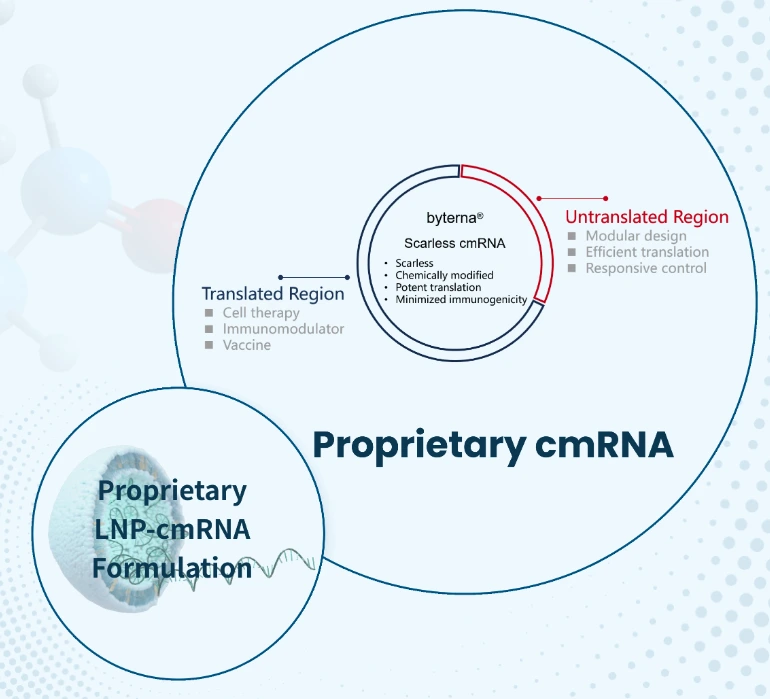
Credit: Byterna Therapeutics
Moreover, the byteModi platform applies precise chemical changes to the cmRNA backbone to increase protein expression and lower immunogenicity.
Further, the Byterna.AI platform leverages advanced algorithms to design better RNA sequences, while the CellectLNP system delivers cmRNA to specific cell types with high T-cell transfection and low off-target effects.
8. Organoids & Organ-on-Chip models: Market to Reach USD 6.5 B
The global human organoids market is expected to reach USD 6.5 billion by 2033 at a 22.5% CAGR. Organ-on-chip models also show growth, with forecasts rising from USD 950 million in 2030 to over USD 10.10 billion by 2033.
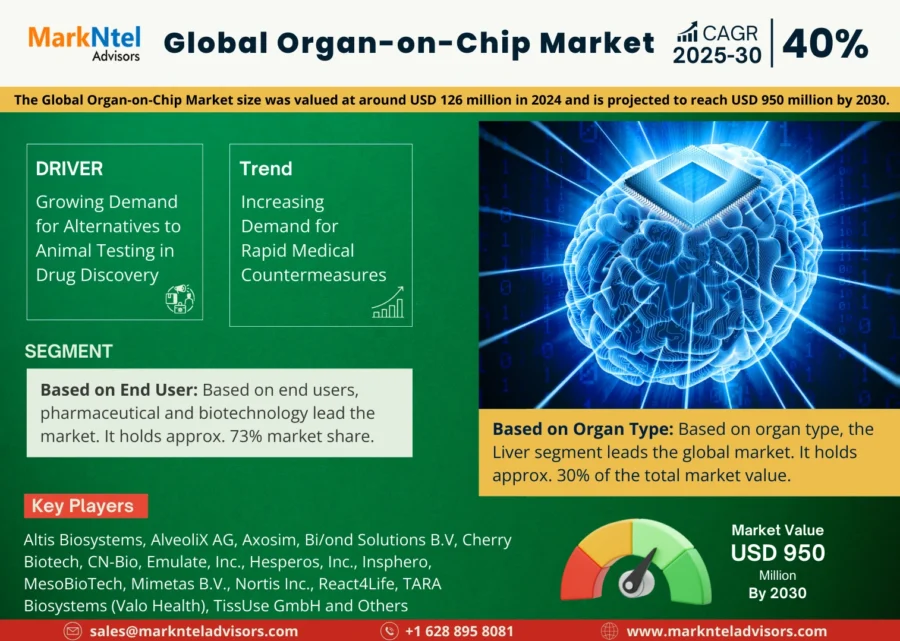
Credit: MarkNtel Advisors
The National Science Foundation committed USD 14 million to biocomputing and organoid intelligence for advancing cell-based models and disease research. MIMETAS also joined a EUR 124 million Dutch government project focused on animal-free medical research.
However, manufacturing organoids and organ-on-chip systems is expensive. For instance, liver-on-chip models range from USD 20 000 to USD 150 000 each. Special materials and microfluidic designs increase these costs. Moreover, finding high-quality primary cells and building standardized processes block progress.
In response, researchers build bioreactors and encapsulation tools that scale up production, automate steps, and apply AI to improve testing and accuracy. New materials, like cyclic olefin copolymer (COC), polymethyl methacrylate (PMMA), and biocompatible 3D-printed resins, solve issues like leakage and small-molecule absorption. These materials also support more accurate, multi-organ disease models that are useful in early drug testing, toxicology, personalized cancer care, and regenerative medicine.
Further, NETRI received EUR 5 million in equity to build large organ-on-chip production sites. Queen Mary University also received a GBP 7 million award to train researchers in organ-on-chip science. TissUse received a grant to advance multi-organ chip models for tuberculosis screening and safety testing.
Solid IO provides Tumor-on-Chip Diagnostics
Finnish startup Solid IO builds a tumor-on-chip platform that copies the patient tumor microenvironment to provide real-time, patient-specific insights into treatment responses. The platform combines bioengineering and AI to model immune interactions and predict how different immuno-oncology therapies impact an individual’s cancer.
Moreover, the platform utilizes each patient’s biological profile to deliver high-accuracy predictions and works across multiple cancer types. It guides therapeutic choices early in the clinical process to support treatment planning and accelerate drug development.
RadaHaim works on Organoid Cultivation & Sorting
South Korean startup RadaHaim develops organoid technologies that improve reproducibility, scalability, and precision in biomedical research. It uses automated processes for organoid mass production. This enables consistent output and is suited for high-throughput applications.
Further, the startup utilizes 3D suspension culture to maintain stable growth conditions for enhancing organoid performance. Its precision sorting technology isolates and classifies organoids to create reliable models for various research and clinical needs.
9. Nanomedicine & Smart Drug Delivery: A USD 799 B+ Market by 2034
The nanomedicine market is on an upward trajectory with projections to reach USD 799.6 billion by 2034 at a CAGR of 11.6%. Moreover, the smart drug delivery market is also expected to reach USD 48.3 billion by 2034 with a 17% CAGR.
This market momentum drives higher investor confidence. Investments for regenerative medicine and vaccination in the nanomedicine domain are expected to grow by at least 2.6 times by 2030. Within this, diagnostics and drug delivery receive most of the funding.
For instance, Johnson & Johnson committed USD 2.7 billion in milestone payments to Nanobiotix for its nanoparticles used in radiotherapy for head and neck cancer.
However, unclear behavior of nanomedicines in the body, product quality differences, and a lack of global regulations slow their use in clinics. Other issues include problems with scaling production, high costs, and low rates of successful clinical use. Nanoparticles still struggle to cross biological barriers and often trigger immune responses.
To tackle these issues, leading companies use mixed strategies by combining new technology with partnerships across industries to speed up development and lower risks. For example, NanoSmart Pharmaceuticals develops tumor-targeted nanomedicine platforms by using human-derived antibodies to improve drug delivery for solid tumor cancers. Likewise, Cello Therapeutics engineers a biomimetic nanoparticle platform for cancer drug delivery
Further, new technologies, especially those using AI to design smart nanoparticles, improve how drugs load and release, and predict how they interact with the body. These tools shorten development timelines for targeted treatments.
Researchers also use quality-by-design (QbD) and predictive tools to meet regulatory expectations while keeping control over consistency, safety, and risk. Moreover, IoT-enabled drug delivery systems, cloud-based tracking, and subscription-driven remote care services enable continuous patient monitoring, personalized treatment, and improved therapy adherence.
Phos4nova manufactures Medical Imaging Polymers
Dutch startup Phos4nova builds polyphosphoester (PPE)-based technology that uses built-in imaging and drug delivery functions to support early disease diagnosis and targeted therapy.
Its Phos4MR platform leverages a proprietary polymer backbone to offer a clear, background-free 31P magnetic resonance imaging (MRI) signal. It does not toxic agents like heavy-metal chelates, radionuclides, or synthetic cytotoxins.
At the same time, the startup’s PPEylate technology assists nanoparticles to stay stable in the bloodstream and avoid immune detection. It also prevents anti-polyethylene glycol (anti-PEG) responses and improves nanomedicine delivery.
Doxanano creates Targeted Chemotherapy Nanomedicine
French startup Doxanano offers DXN, a polymersome-based drug delivery platform. It provides remotely activated chemotherapy (RAC) for localized drug release in solid tumors.
DXN uses stable, redox-sensitive polymer vesicles to carry cytotoxic agents and travel safely through the body after intravenous injection. When exposed to targeted X-ray radiation, these polymersomes break open at the tumor site to release the drugs without harming nearby healthy tissues.
Further, the platform handles hydrophilic and hydrophobic drug combinations. This includes non-invasive imaging and avoids the need for biological targeting.
Doxanano also combines systemic delivery with targeted activation by using approved cancer therapy materials for digestive as well as head and neck cancer treatment.
10. Virtual & Decentralized Clinical Trials: Saves 10-25% in Costs
Virtual trials and DCTs compress timelines by integrating remote biosample collection, digital biomarkers, and real-time analytics. This converts passive participants into active data generators.
Moreover, the DCT market is expected to reach USD 21.34 billion by 2030, with a CAGR of 14.16%. In North America and Europe, the digital decentralized trial (DDCT) market is projected to reach USD 9.13 billion by 2026 at a CAGR of 38.5%.
By then, DDCTs are expected to cover over 20% of outsourced clinical trials in these regions, compared to just 2.8% in 2020. Additionally, companies using DCTs report saving 10-25% in costs, with faster launches due to enhanced recruitment, digital sign-ups, and access to real-world data (RWD).
However, meeting different global rules, handling data privacy laws across countries, and validating digital tools for approval remain key challenges. To address these issues, clinical trial sponsors and research groups work closely with regulatory bodies early in the process. Some of these include the U.S. Food and Drug Administration (FDA), the European Medicines Agency (EMA), and national authorities like the UK’s regulator under the Medicines and Medical Devices Act.
Several companies show real progress using advanced technology in trials. Medable, for example, built a full cloud platform that includes eConsent, patient contact tools, and remote monitoring to improve trial speed and participation.
Likewise, ICON launched adaptive protocols powered by AI to adjust trial steps in real time. The adaptive protocols reduce delays and enable subgroup analysis in decentralized cancer trials. Science 37 further developed patient portals that collect electronic patient-reported outcome (ePRO) data from devices, use AI to flag compliance issues, and send nurses to patients’ homes when needed.
Mimi-Q offers a Pharmacokinetic (PK) Data Platform
German startup Mimi-Q develops a PK data platform for virtual clinical trials. It predicts clinical outcomes using virtual patient modeling and adaptive in vitro testing. The platform combines in-silico simulations of drug transport and pharmacokinetics across diverse patient populations.
In addition, the platform utilizes in vitro disease response models to generate clinically relevant data after drug administration. It merges these two data streams to simulate full trial scenarios and evaluate treatment protocols in advance. This combination offers validation through population-level predictions.
Adsilico provides Virtual Device Testing
UK-based startup Adsilico builds an in silico trial technology using generative AI. It combines computational modeling and simulation to assess the safety and performance of medical devices in virtual patients.
The technology builds high-fidelity, simulation-ready models of human anatomy, physiology, and pathology. It then evaluates device designs without human testing to spot poor-performing designs early on. This reduces R&D costs and reduces patient risk.
Discover all Healthcare Trends, Technologies & Startups
As the medical research industry evolves, advances in AI, gene editing, mRNA therapies, organoids, and quantum technologies converge. These innovations drive faster discovery, personalized care, and more precise treatment development.
Alongside these, emerging areas like digital biomarkers, microbiome-based therapies, multi-omics integration, and synthetic biology gain momentum. Adapting this next era of medical research builds a foundation for smarter, more inclusive, and future-ready healthcare systems.
The Healthcare Trends & Startups outlined in this report only scratch the surface of trends that we identified during our data-driven innovation & startup scouting process. Identifying new opportunities & emerging technologies to implement into your business goes a long way in gaining a competitive advantage.
![Dive into the Top 10 Innovations and Trends in Medical Research [2026]](https://www.startus-insights.com/wp-content/uploads/2025/07/Trends-in-Medical-Research-SharedImg-StartUs-Insights-noresize-420x236.webp)


![Discover the Top 10 Recent Trends in Laser Technology [2026]](https://www.startus-insights.com/wp-content/uploads/2025/08/Recent-Trends-in-Laser-Technology-SharedImg-StartUs-Insights-noresize-420x236.webp)





